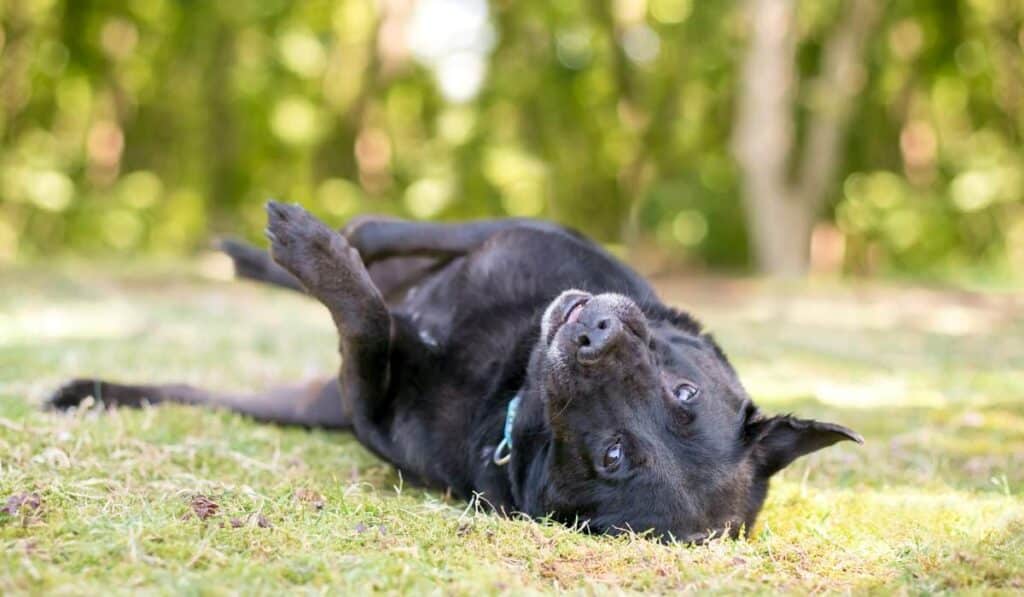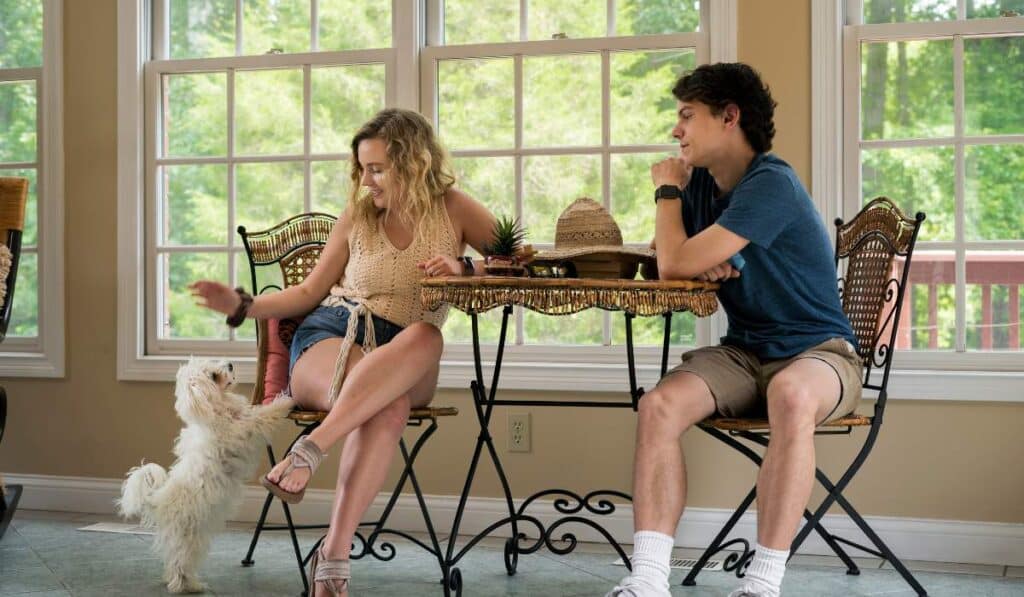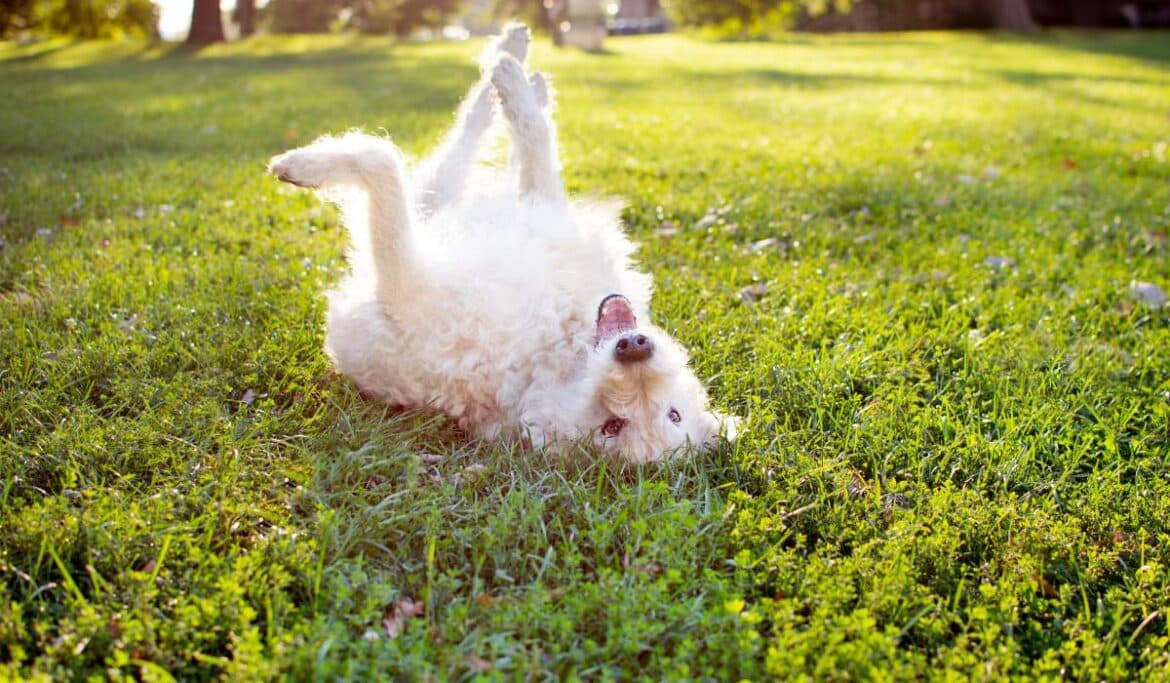Have you ever wondered why your furry friend dogs roll on their back and wiggle around? This behavior is quite common among dogs, but it can be perplexing to pet owners. The reason behind this behavior varies depending on the context. As a responsible pet owner, understanding why your dog does this can help you better communicate with them.
We'll cover everything from the vet's perspective to the reasons that your pet may be doing this at home. With our expert insight, you'll have a better understanding of what your dog is trying to tell you.
So, if you've ever found yourself wondering about this peculiar behavior, keep reading!
The Meaning Behind Dog's Back Rolling and Wiggling

Dogs use body language to communicate with humans and other animals.
As a dog owner, you have probably noticed that your furry friend uses various forms of body language to communicate with you. From wagging their tail to barking, dogs use different cues to convey their emotions and intentions. One common behavior that many dogs exhibit is rolling on their backs and wiggling around. But what does this mean?
Rolling on their back can indicate submission or playfulness.
When a dog rolls on its back, it can be an indication of submission or playfulness. In the wild, submissive dogs may roll over as a way of showing respect to more dominant pack members. Domesticated dogs often display this behavior when meeting new people or other animals as a way of communicating non-threatening intentions.
On the other hand, some dogs may roll over as part of their playtime routine. They may invite you or another dog to engage in roughhousing by exposing their belly and waiting for you to initiate play.
Wiggling is often a sign of excitement or anticipation.
Dogs are known for being playful creatures, and wiggling is one way they express excitement or anticipation. When your dog sees something they like (like their favorite toy), they might start wiggling uncontrollably in excitement.
Wiggling can also be a sign that your dog wants attention from you. If your pup starts wiggling when you come home from work, it could be because they missed you and want some affectionate cuddles.
Understanding these cues can help you interpret your dog's behavior.
It's essential to understand your dog's body language so that you can better communicate with them. By recognizing the meaning behind behaviors like rolling over and wiggling around, you'll be able to tell when your pup is feeling anxious, excited, happy, or playful.
For example, if your dog is rolling over and exposing their belly, it might be a sign that they're feeling submissive or want to play. On the other hand, if they're wiggling around frantically and barking loudly, they may be trying to tell you that something is wrong (like an itch or worry).
Common Reasons for Dogs to Roll on Their Backs
Dogs are known for their quirky behaviors, and one of the most common is rolling on their backs and wiggling with excitement. While it may seem like a strange thing to do, there are actually several reasons why dogs engage in this behavior.
Submission
One reason why dogs roll on their backs is to show submission to another dog or human. Rolling over and exposing their belly is a vulnerable position that indicates they are not a threat. In the wild, submissive behavior can help prevent aggression from dominant pack members.
If your dog rolls over when meeting new dogs or people, it's likely a sign of respect rather than fear. It's important to allow them to approach at their own pace and avoid forcing them into uncomfortable situations.
Playfulness
Another reason why dogs roll on their backs is to invite others to play. This behavior is often accompanied by wiggling and tail wagging, indicating that they want attention and interaction.
If your dog rolls over during playtime, it's a good sign that they're having fun and enjoying themselves. You can encourage this behavior by engaging in games like tug-of-war or fetch.
Belly Rubs
Dogs love affection from humans, and rolling on their backs can be an invitation for belly rubs. Many dogs enjoy having their bellies rubbed as it feels good and provides physical contact with their owners.
However, it's important to note that not all dogs enjoy belly rubs. Some may become uncomfortable or even aggressive if touched in this area. Always pay attention to your dog's body language and respect their boundaries.
Cooling Down
Finally, some dogs roll on their backs as a way of cooling down. Exposing the belly allows heat to escape from the body more easily, which can be helpful in hot weather or after exercise.
It's important to keep an eye out for signs of overheating, such as excessive panting or lethargy. If your dog is showing signs of heat exhaustion, move them to a cooler area and provide water.
While rolling on their backs can be a normal behavior for dogs, it's important to keep an eye out for any changes in their behavior. If your dog suddenly starts rolling excessively or seems uncomfortable, it could be a sign of a skin infection or other underlying health issue.
Interpreting Your Dog's Body Language When They Roll on Their Backs

Dogs are adorable pets that bring joy and happiness to their fur parents. However, as much as we love our furry friends, it can be challenging to understand their body language signals. One of the most common behaviors that dogs exhibit is rolling on their backs and wiggling.
Pay attention to other body cues such as ears, eyes, and tail position when interpreting your dog's behavior.
When a dog rolls on its back, it may indicate different things depending on the situation. For example, if your pup is relaxed with its tail wagging while rolling over for a belly rub or playing fetch with you, it means they're happy and playful. On the other hand, if your canine friend rolls over in fear or submission with its ears pinned back and tail tucked between its legs, it may mean they feel uncomfortable or threatened by something/someone around them.
To better understand what your dog is trying to communicate through its body language signals when rolling over on its back, pay attention to other cues such as eye contact (if any), ear position (upright or flattened), mouth/lip movements (licking or yawning), and tail position (wagging or tucked). These additional indicators can help you decode your fur baby's message more accurately.
If they are relaxed and wagging their tail, it may be a sign of playfulness or relaxation rather than submission or fear.
A relaxed dog that rolls over onto its back with a wagging tail often indicates playfulness or relaxation. They might want you to give them belly rubs or scratch their bellies because they enjoy being pampered by their fur parents. It could also be an invitation for playtime, indicating that they want to play with you or other dogs around them.
If they are tense with their ears pinned back, it may indicate discomfort or fear.
On the other hand, if your dog rolls over with its ears pinned back and tail tucked between its legs, it could mean they feel threatened or uncomfortable. It's essential to keep in mind that when a dog is scared or anxious, it might lash out by growling or biting. So, be careful not to approach them abruptly in such situations.
Other body language signals to look out for include lip licking, scratching, and smelling.
Apart from rolling on their backs and wiggling, dogs use other body cues to communicate their feelings. For instance, lip licking can indicate anxiety or stress in dogs. Scratching can signify irritation or discomfort caused by fleas/ticks on their skin. Smelling is also an essential communication tool for canines as they use their sense of smell to gather information about their environment.
Back Rolling and Its Connection to Play Behavior in Dogs
The Invitation for Interaction
If you've ever seen a dog roll over onto their back and wiggle around, you might have wondered what they're doing. This behavior is called "back rolling," and it's actually quite common among dogs. One of the main reasons why dogs roll over onto their backs is that it's an invitation for interaction with other dogs or humans.
When a dog rolls over onto their back during playtime, they are essentially saying, "Hey, come play with me!" This position is known as the "play bow," and it's a signal to other dogs that the rolling dog wants to engage in some friendly play. When another dog sees this behavior, they will often approach the rolling dog and start playing with them.
Establishing Social Bonds
Backrolling isn't just about inviting other dogs to play; it also helps establish social bonds among dogs. When two dogs play together, they are learning how to communicate with each other effectively. They are also learning about each other's boundaries and limitations.
By rolling over onto its back during playtime, a dog is showing that they trust the other dog enough to expose its vulnerable belly. This vulnerability can help build trust between two dogs and strengthen their bond.
Learning Social Cues and Boundaries
In addition to building social bonds, back-rolling can also help dogs learn social cues and boundaries. When one dog rolls over onto their back during playtime, the other dog will usually respond by backing off or changing their behavior in some way.
For example, if a dog gets too rough during playtime and accidentally hurts another dog, the injured dog may roll over onto their back as a way of saying "stop." The other dog will then usually stop playing or adjust their behavior in response.
By using these types of signals during playtime, dogs can learn important social cues and boundaries that will help them interact more effectively with other dogs in the future.
Unusual Reasons Why Dogs Roll on Their Backs and Wiggle

Medical Issues
Dogs are known for their playful nature, but sometimes they may roll over due to pain or discomfort. If your pooch is rolling over more than usual, it could be a sign of an underlying medical issue that needs attention. Skin irritation is one such issue that can cause dogs to roll over frequently. They may also do this if they have an injury or inflammation in their joints.
If you notice your dog rolling over excessively, take them to the vet to rule out any medical issues. It's always better to be safe than sorry.
Attention-Seeking Behavior
Dogs crave attention from their owners and rolling over can be a way for them to get it. When a dog rolls on its back, it exposes its belly, which is a vulnerable area. This position shows trust in their owner and invites affectionate petting or belly rubs.
Some dogs may even use this behavior as a way of getting what they want. For example, if they want a treat or toy, they might roll over and look up at their owner with pleading eyes until they get what they want.
Marking Behavior
Another reason why dogs roll on their backs and wiggle is marking behavior. Dogs have scent glands all over their bodies, including on their bellies. By rubbing themselves against surfaces while rolling around, dogs can leave behind their scent as a way of marking territory.
This behavior is particularly common in male dogs who are trying to establish dominance or attract mates. However, female dogs may also exhibit this behavior during heat cycles as a way of attracting potential mates.
Exercise and Playtime
Sometimes dogs just like to let loose and have some fun! Rolling around on their backs is an excellent way for them to stretch out and exercise those muscles after being cooped up inside all day.
If you notice your dog rolling over and wiggling around during walks or playtime, it's likely just a sign that they're feeling happy and playful. Encourage this behavior by playing with them and providing plenty of opportunities for exercise.
Every Dog is Unique
Remember that every dog is unique, so it's essential to observe your pet's individual behaviors. Some breeds may be more prone to rolling over than others due to their personality traits or physical characteristics.
For example, smaller breeds like Chihuahuas and Yorkshire Terriers may be more likely to roll over due to their smaller size and vulnerability. On the other hand, larger breeds like Great Danes or Mastiffs may be less likely to roll over due to their size and strength.
Why do dogs roll on their backs and wiggle?
In conclusion, dogs roll on their backs and wiggle for various reasons. Some of the common reasons include showing submission, inviting play, or even asking for belly rubs. The behavior can also be a way to communicate with other dogs or humans. It is important to understand your dog's body language when they roll on their back to determine what they are trying to convey.
What does it mean when a dog rolls on its back and wiggles?
When a dog rolls on its back and wiggles, it can mean different things depending on the context. It could be a sign of submission or an invitation to play. In some cases, it could also indicate that the dog wants attention or affection from its owner.
Is it normal for dogs to roll on their backs?
Yes, it is completely normal for dogs to roll on their backs. Rolling over is a natural behavior that dogs use to communicate with other animals and humans.
How do I know if my dog wants me to rub its belly?
If your dog rolls over onto its back and exposes its belly, it may be asking you for a belly rub. However, it's important to read your dog's body language carefully as not all dogs enjoy having their bellies rubbed.
Can rolling on the back be a sign of aggression in dogs?
While rolling over onto the back can sometimes be a sign of submission in dogs, it is not typically associated with aggression. Aggressive behaviors in dogs usually involve growling, snarling, biting, or snapping.
Call-to-Action
If you notice your dog rolling over onto its back frequently, take some time to observe their behavior closely. This will help you better understand what they are trying to communicate with you or other animals around them.
Remember that every dog is unique and may have different reasons for rolling over onto their back. By paying attention to your dog's body language and behavior, you can build a stronger bond with them and provide the care they need.
Frequently Ask Questions (FAQs)
Please find below some additional FAQs that might be helpful:
Why do dogs roll on their backs in the grass?
Rolling on their backs in the grass is a way for dogs to scratch an itch or get rid of any irritants on their skin. It can also be a sign of enjoyment or playfulness.
Can rolling over onto its back be a sign of fear in dogs?
In some cases, rolling over onto the back can be a sign of fear or anxiety in dogs. This is typically accompanied by other signs such as flattened ears, tucked tail, and avoidance behavior.
Do all dogs enjoy belly rubs?
No, not all dogs enjoy having their bellies rubbed. Some may find it uncomfortable or even threatening. It's important to read your dog's body language carefully to determine if they are enjoying the experience.
Is it safe to rub my dog's belly?
Yes, rubbing your dog's belly can be safe as long as it is done gently and with care. However, it's important to avoid putting too much pressure on sensitive areas such as the ribcage.
Can rolling over onto its back be a sign of illness in dogs?
While rolling over onto the back is usually a normal behavior for most dogs, excessive rolling could indicate an underlying medical condition such as skin irritation or allergies. If you notice any unusual behaviors or symptoms in your dog, it's best to consult with a veterinarian.


